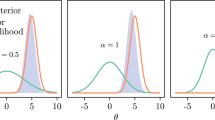Abstract
This paper deals with the frequently encountered problem of pre-posterior data evaluation, i.e., assessment of the value of data before they become available. The role of data is to reduced the risk associated with decisions taken under conditions of uncertainty. However, while the inclusion of relevant data reduces risk, data acquisition involves cost, and there is thus an optimal level beyond which any addition of data has a negative net benefit. The Bayesian approach is applied to construct a method for updating decisions and evaluating the anticipated reduction in risk following consideration of additional data. The methodology is demonstrated on a problem of management of an aquifer under threat of contamination.
Similar content being viewed by others
Abbreviations
- L :
-
matrix of losses for all combinations of states and decisions
- l, m, h :
-
possible salinity levels from the proposed borehole
- N, M, F :
-
possible decisions
- P(·):
-
vector of prior probabilities of states
- P(.|l), P(.|m), P(.|h):
-
conditional (updated) probability vectors of the different states given the salinity levels
- P(.|ν), P(.|μ), P(.|ϕ):
-
probability vectors of the different salinity levels given the true states (likelihood function)
- P(l), P(m), P(h) :
-
probabilities of the salinity levels, irrespective of the true state
- R(.|l), R(.|m), R(.|h):
-
posterior risk vectors of the different decisions given the salinity levels
- R(N), R(M), R(F) :
-
prior risk associated with different decisions
- ⋎, μ, ϕ:
-
possible true states
References
Benjamin, J. R. and Cornell, C. A., 1970, Probability, Statistics, and Decisions for Civil Engineers, McGraw-Hill, New York.
Dawdy, D. R., 1979, The worth of hydrologic data, Wat. Resour. Res. 15, 1726–1732.
de Groot, M., 1970, Optimal Statistical Decisions, McGraw-Hill, New York.
Jeffreys, H., 1961, Theory of Probability, Clarendon, Oxford.
Khinchin, A. I., 1957, Mathematical Foundations of Information Theory, Dover, New York.
Konikow, L. F. and Bredehoeft, J. D., 1984, Computer model of two-dimensional solute transport and dispersion in ground water, Book 7, Chapter C2, Techniques of Water-Resources Investigations of the United States Geological Survey, United States Government Printing Office, Washington.
Zellner, A., 1971, An Introduction to Bayesian Inference in Economics, John Wiley, New York.
Author information
Authors and Affiliations
Rights and permissions
About this article
Cite this article
Ben-Zvi, M., Berkowitz, B. & Kesler, S. Pre-posterior analysis as a tool for data evaluation: Application to aquifer contamination. Water Resour Manage 2, 11–20 (1988). https://doi.org/10.1007/BF00421927
Received:
Accepted:
Issue Date:
DOI: https://doi.org/10.1007/BF00421927




